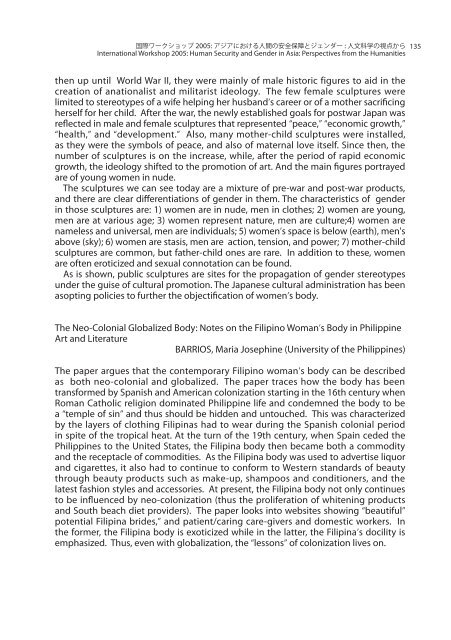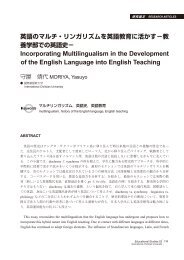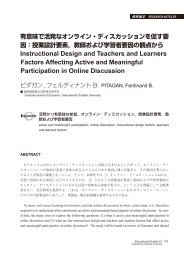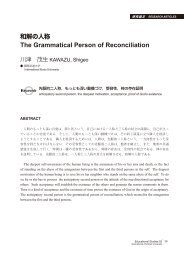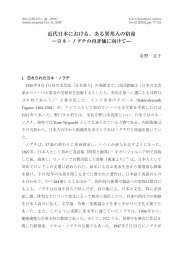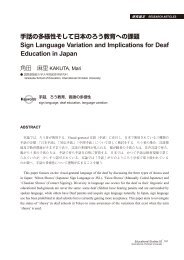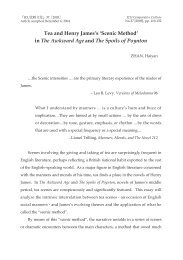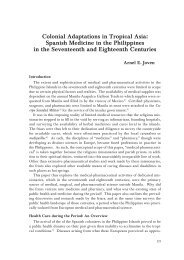Untitled - subsite - å½éåºç£æ大å¦
Untitled - subsite - å½éåºç£æ大å¦
Untitled - subsite - å½éåºç£æ大å¦
Create successful ePaper yourself
Turn your PDF publications into a flip-book with our unique Google optimized e-Paper software.
2005: : 135<br />
International Workshop 2005: Human Security and Gender in Asia: Perspectives from the Humanities<br />
then up until World War II, they were mainly of male historic figures to aid in the<br />
creation of anationalist and militarist ideology. The few female sculptures were<br />
limited to stereotypes of a wife helping her husbands career or of a mother sacrificing<br />
herself for her child. After the war, the newly established goals for postwar Japan was<br />
reflected in male and female sculptures that represented peace, economic growth,<br />
health, and development. Also, many mother-child sculptures were installed,<br />
as they were the symbols of peace, and also of maternal love itself. Since then, the<br />
number of sculptures is on the increase, while, after the period of rapid economic<br />
growth, the ideology shifted to the promotion of art. And the main figures portrayed<br />
are of young women in nude.<br />
The sculptures we can see today are a mixture of pre-war and post-war products,<br />
and there are clear differentiations of gender in them. The characteristics of gender<br />
in those sculptures are: 1) women are in nude, men in clothes; 2) women are young,<br />
men are at various age; 3) women represent nature, men are culture;4) women are<br />
nameless and universal, men are individuals; 5) womens space is below (earth), men's<br />
above (sky); 6) women are stasis, men are action, tension, and power; 7) mother-child<br />
sculptures are common, but father-child ones are rare. In addition to these, women<br />
are often eroticized and sexual connotation can be found.<br />
As is shown, public sculptures are sites for the propagation of gender stereotypes<br />
under the guise of cultural promotion. The Japanese cultural administration has been<br />
asopting policies to further the objectification of womens body.<br />
The Neo-Colonial Globalized Body: Notes on the Filipino Womans Body in Philippine<br />
Art and Literature<br />
BARRIOS, Maria Josephine (University of the Philippines)<br />
The paper argues that the contemporary Filipino womans body can be described<br />
as both neo-colonial and globalized. The paper traces how the body has been<br />
transformed by Spanish and American colonization starting in the 16th century when<br />
Roman Catholic religion dominated Philippine life and condemned the body to be<br />
a temple of sin and thus should be hidden and untouched. This was characterized<br />
by the layers of clothing Filipinas had to wear during the Spanish colonial period<br />
in spite of the tropical heat. At the turn of the 19th century, when Spain ceded the<br />
Philippines to the United States, the Filipina body then became both a commodity<br />
and the receptacle of commodities. As the Filipina body was used to advertise liquor<br />
and cigarettes, it also had to continue to conform to Western standards of beauty<br />
through beauty products such as make-up, shampoos and conditioners, and the<br />
latest fashion styles and accessories. At present, the Filipina body not only continues<br />
to be influenced by neo-colonization (thus the proliferation of whitening products<br />
and South beach diet providers). The paper looks into websites showing beautiful<br />
potential Filipina brides, and patient/caring care-givers and domestic workers. In<br />
the former, the Filipina body is exoticized while in the latter, the Filipinas docility is<br />
emphasized. Thus, even with globalization, the lessons of colonization lives on.


